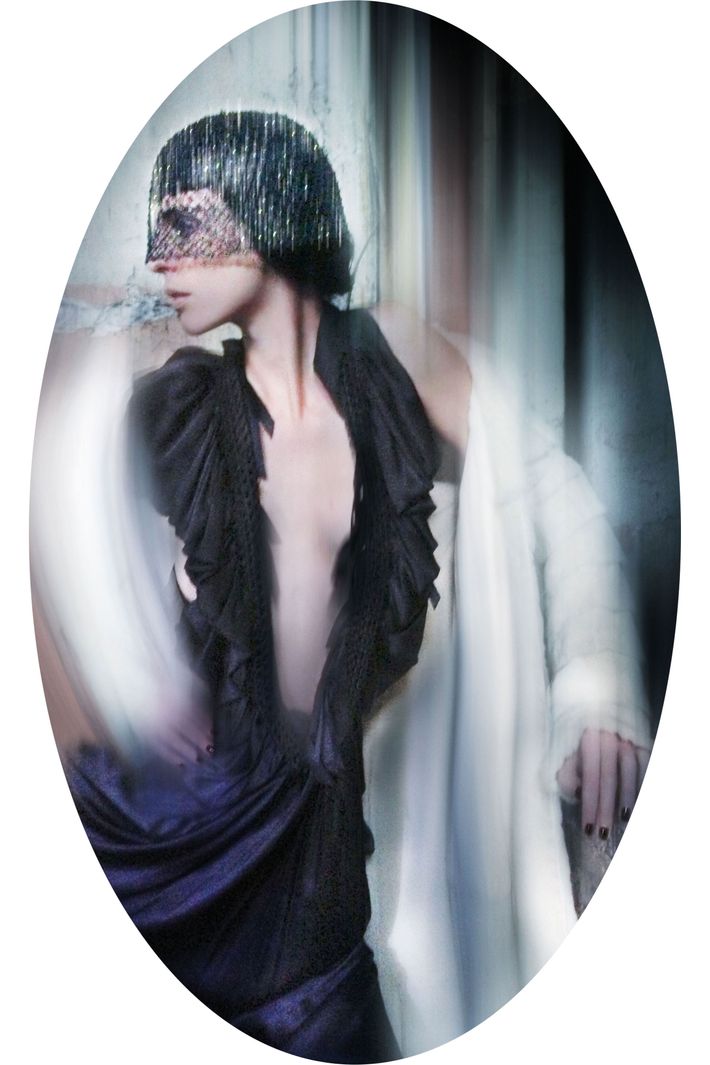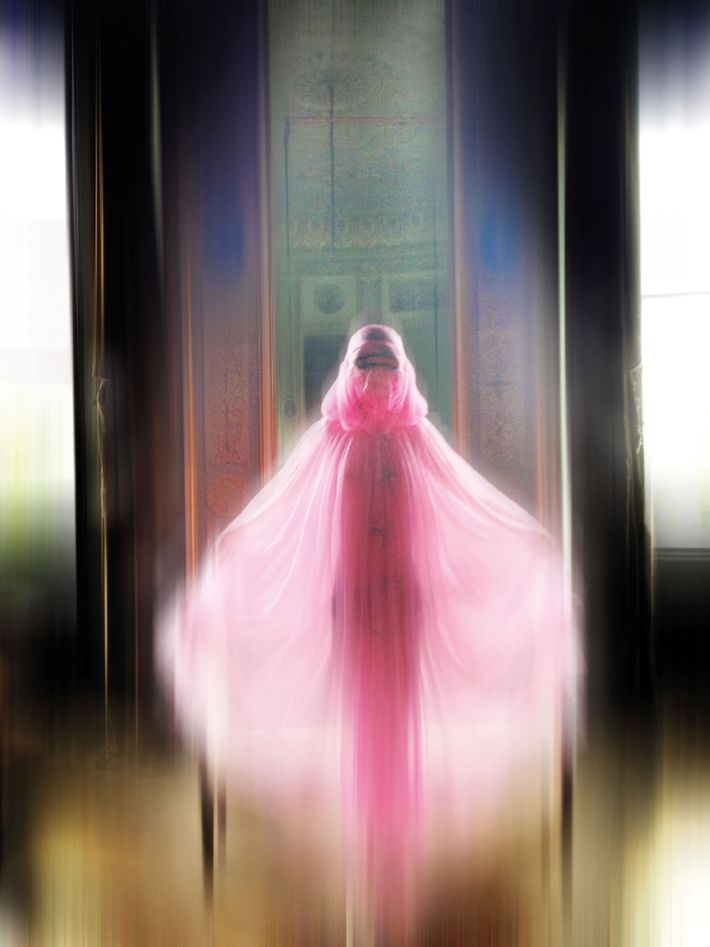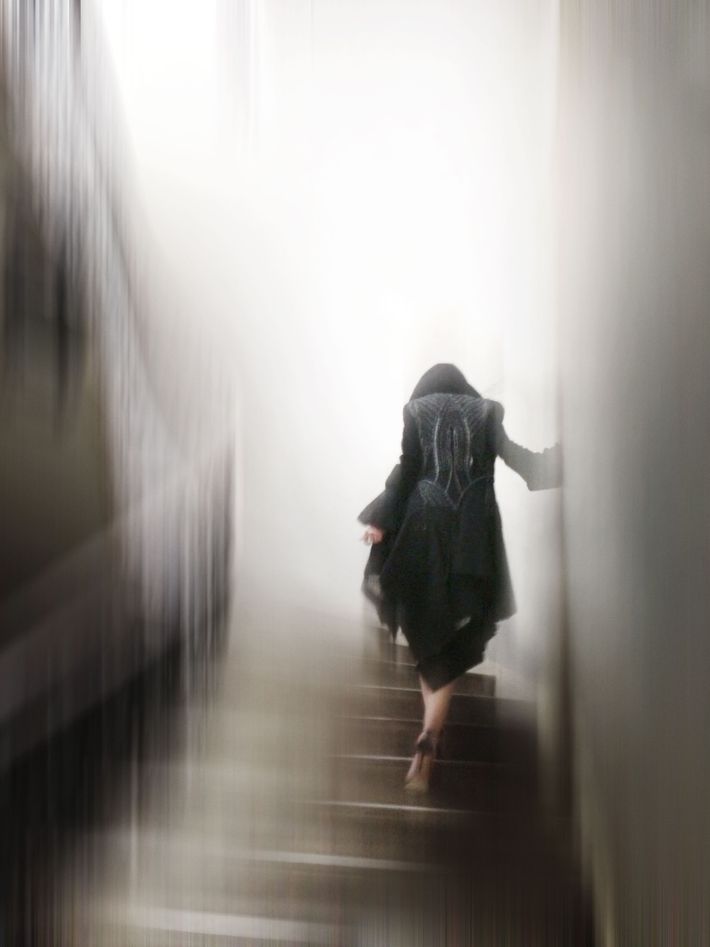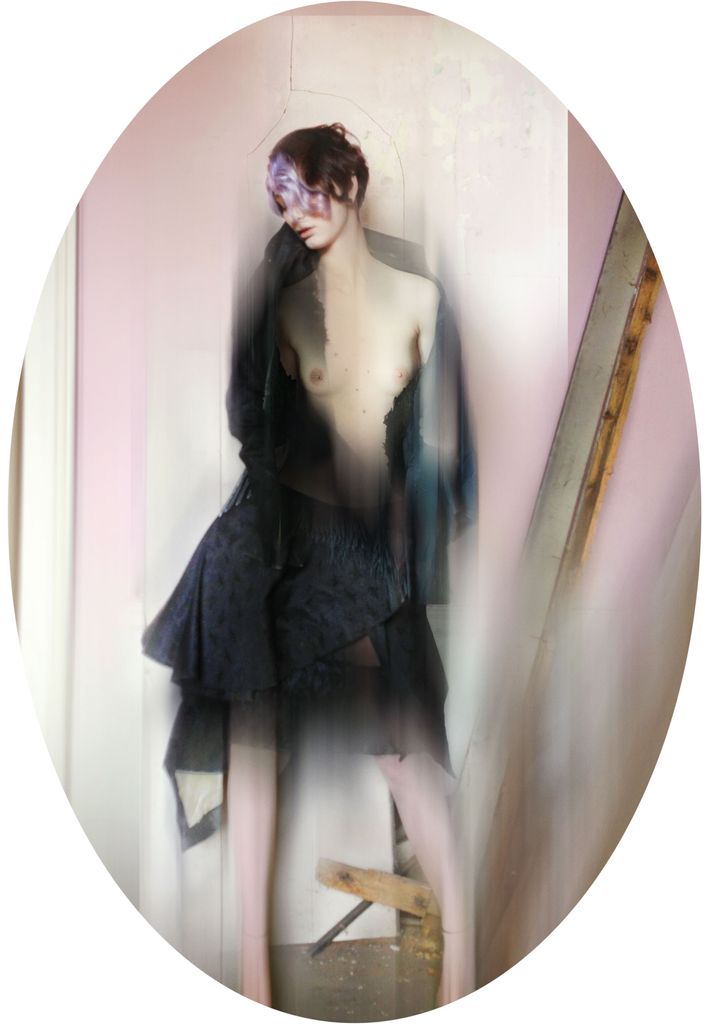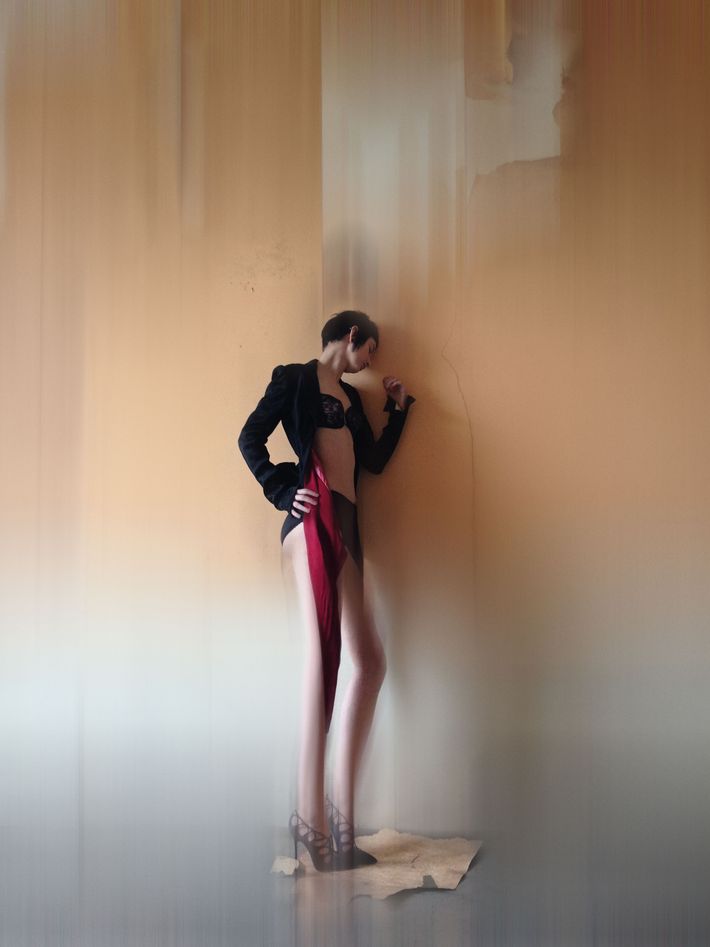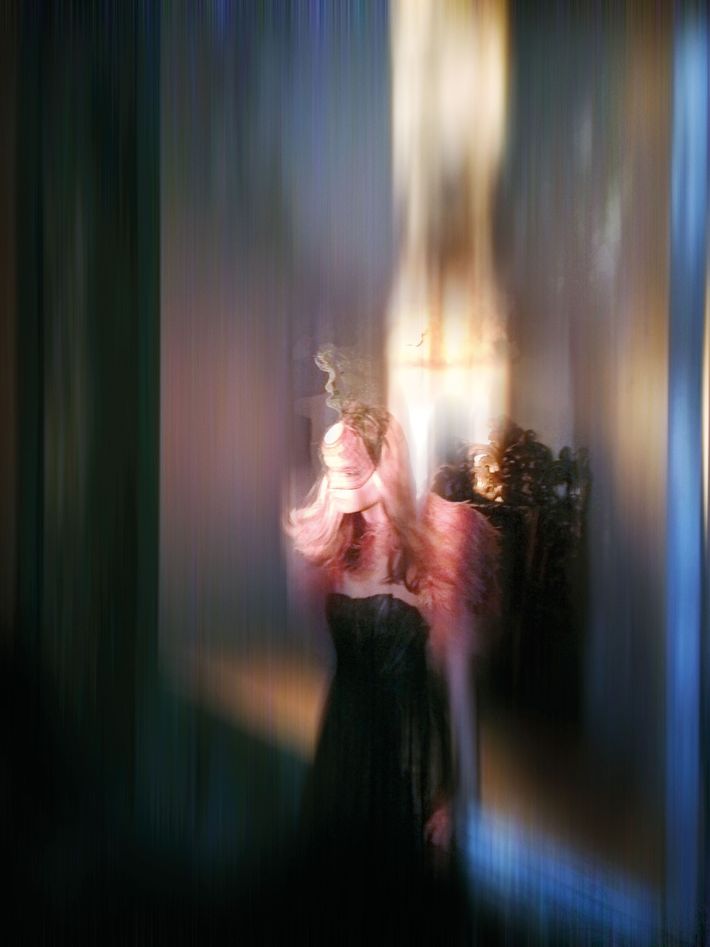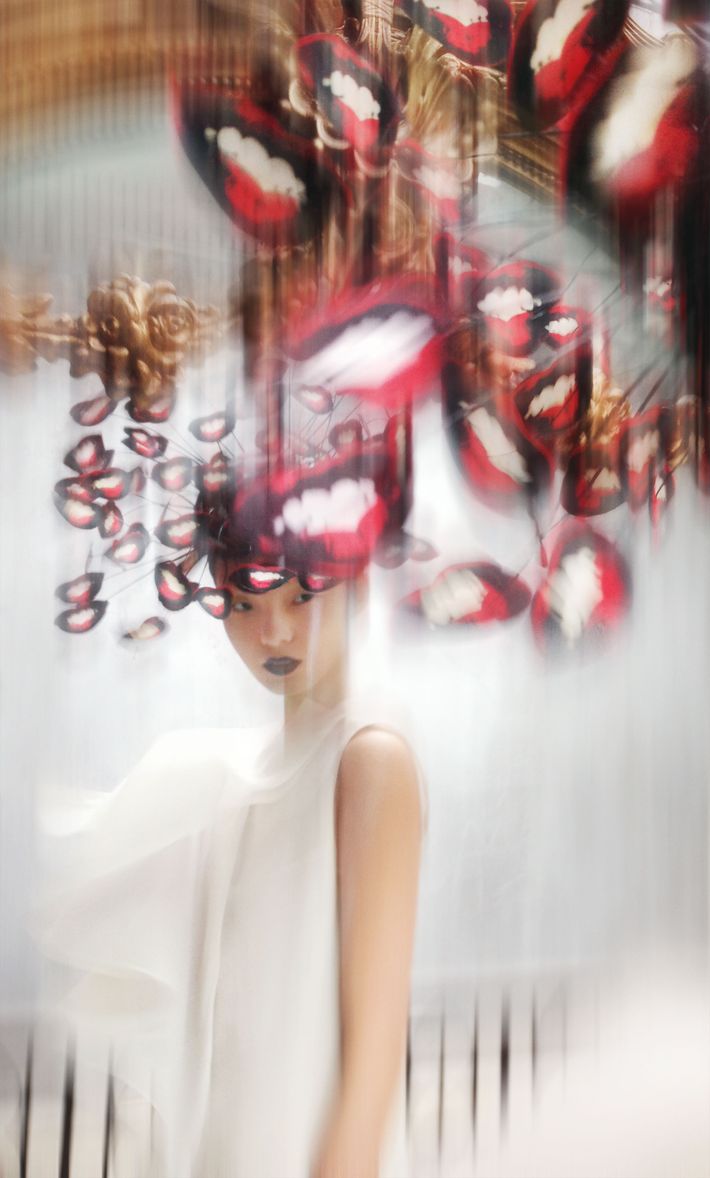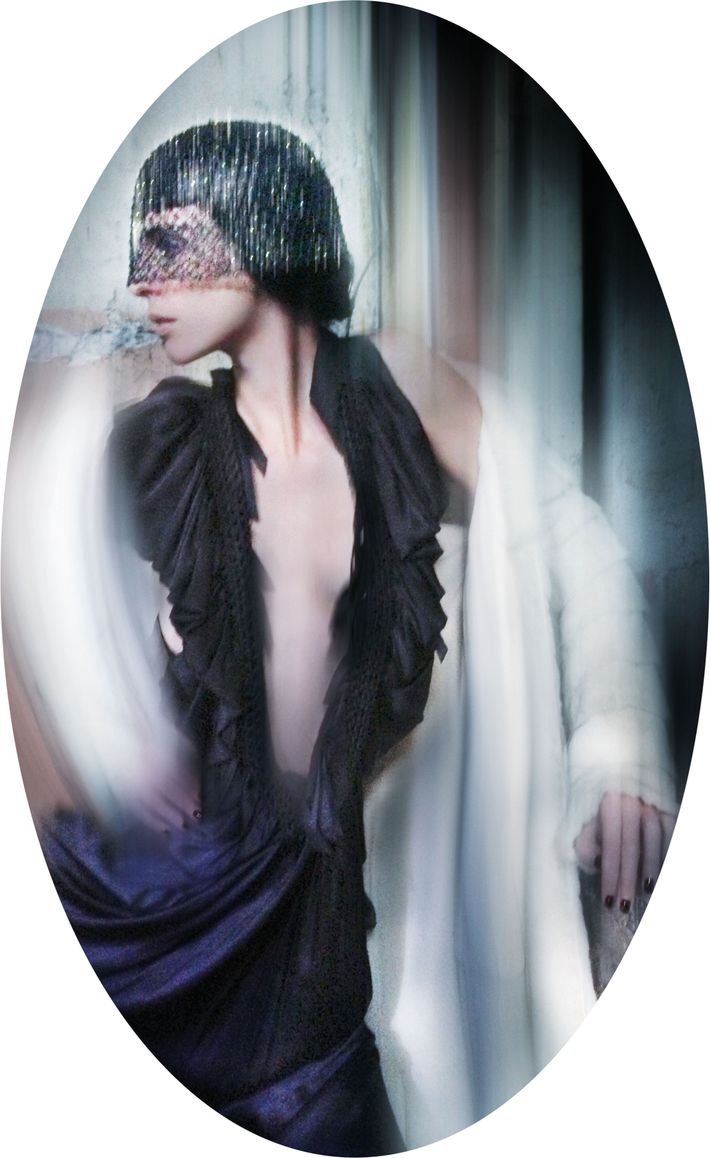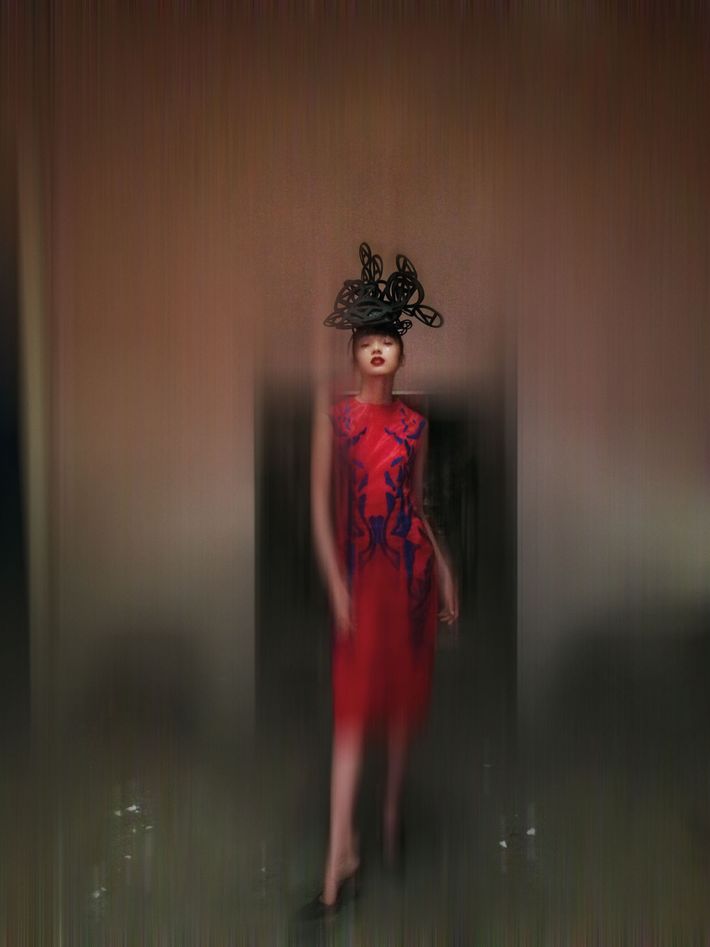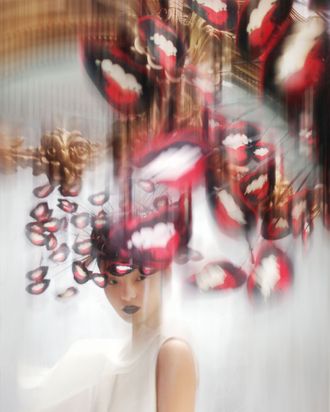
When photographer Nick Knight set out to make a book about his friend Isabella Blow — the late fashion editor known for her eccentric sense of style — he knew that he would stage the photo shoot at Doddington Hall, a stately British estate in Cheshire that felt just a little bit haunted.
Doddington had been in Blow’s family for years, and she told her friends that she wanted to live there someday. But that never happened; Blow took her own life in 2006. The abbey was turned into a boarding school for young girls. When Knight arrived earlier this year, he found cabinets filled with graffiti drawn by the homesick schoolgirls. Running through the basement were abandoned railroad tracks – for trains that brought food and supplies for the students. Off to one corner, Knight found a book and a vial of liquid on a bare shelf. The book was open to a chapter which read, simply, GHOST. Knight called it a “makes-the-hair-stand-up-on-the-back-of-your-neck” moment, which, of course, Isabella “would have loved. If she was there, she’d be laughing her head off with all this,” Knight says.
Doddington in many ways captures the spirit of Blow: She was a person of tremendous creativity and passion, who had a deep and lingering darkness – which extended as far as an obsession with the dark arts. During her lifetime, Blow became known for her larger-than-life style: great twists of sculptural Philip Treacy hats floating above her head like cartoon characters, and structured, embroidered jackets by her close friend, Alexander “Lee” McQueen.
Now, she becomes the focus of a new exhibition: Isabella Blow: Fashion Galore!, at Somerset House in London. I spoke to Knight – the director of Kanye West’s new music video — about shooting the catalog for the show (which will be released in the U.S. by Rizzoli next year), his obsession with Instagram – and what Lady Gaga and Isabella have in common.
This interview has been condensed from its original version.
How did the project for the catalog begin?
We had a meeting early on with Daphne [Guinness] and the people from Somerset House to try and work out how the best way was to represent this collection. Of course, you really want to see Isabella in it, because it’s very much about her way of wearing those clothes. And we went through different ideas: We wondered whether or not we should have all the models all sort of wearing an Isabella mask. That’s a bit sort of Jean-Paul Goude style he did with Grace Jones. We thought, well, that’s not quite right. And then we thought maybe we should use the girls that Isabella championed when she was alive — the Honor Frasers and Sophie Dahls. That didn’t feel quite right either, because this was sort of ten, twenty years ago now. Those girls have changed. So we thought, well, actually, we should just use great girls. The girls that she probably would have loved had she been doing this casting. So we got a set of four or five really lovely models. And also, Isabella’s figure came into play, because a lot of the clothes were fit [for] or changed to fit her. She was quite small, but she had a very large bust, which she was very happy to show. And a lot of models that you get, of course, are quite flat-chested and not very busty. So it was a little bit tricky. So we ended up getting a range of people.
Isabella wore her clothes not as disguise, but more or less as armor. To some degree, to protect herself. But of course, if you’ve got an Alexander McQueen veil on — which goes right down to the floor with lace, and you’ve got a pair of antlers under the veil — it’s hard to see what you look like. Her hats were such a thing with her. Of course, when we put the models in them, all of a sudden, you see the clothes walking down the corridor or posing on the staircase or in a beam of sunlight: Oh, it’s Isabella. It’s almost like she comes back because you have this silhouette again.
I remember meeting her once at the Givenchy couture show, and she was wearing a golden eagle on her head and had twenty feet of very heavy, greasy chain of her — sort of like a chain you might get on a boat or something. You’d see her coming partly because the hat, the lips, everything else. So you didn’t see so much of her. You saw more the clothes. So when you put the clothes back on a person in that context, it was sort of odd and slightly — what’s the word — sort of, [a] vision of her came to life again.
The shoot went on for four days in Doddington Hall. I shot it all on my phone. All on my camera on my phone.
On an iPhone 5?
Yes. They’re pretty good. It’s one of those things that, for all intents and purposes, is as good as using [a camera]. What I really feel I do now is image-making, as opposed to photography. If you were looking at this in terms of a series of paintings, you wouldn’t say, This isn’t good enough because the brushstrokes aren’t fine enough. We’re quite happy to have a bit of abstract expressionism at times, and sometimes you want a real sort of realism in a painting, and it’s the same thing with an image. You know, you don’t necessarily need it to look like an 8 x 10 transparency all the time. And also a lot of these images, they’re about color and form. They’re an expressionistic view of her.
People insist, Oh, you’ve got to use this sort of camera. It’s not really true. The cameras in phones now are perfectly good, whether it’s in the iPhone or Nokia or the Samsung. They’re great. And, of course, when you’re dealing with the ways phones take pictures, it’s incredibly light. I hold it in my hand … It’s not about the pen you’re writing this with or whether it’s a tape that you’re putting it on, it’s about what I say and what you say. It’s the same thing when you’re making images. It’s about what you’re trying to say with the image, not about the equipment you use.
Back to Isabella: Do you remember when and where you first met her?
Not distinctly. I can remember driving past her with my wife on the way into London. We lived just outside of London, in Richmond. Charlotte, my wife, said, “Oh look, there’s Issy.” And you can say, yes, of course it’s Issy, because she had a huge scarlet hat on just walking down the high street. I can remember that as an early sighting of her. I think probably the first time I met her was with Bryan Ferry. I did an album cover for Bryan Ferry, and it was Honor Fraser in an incredible galleon hat that Philip Treacy made for [Isabella], which I think she was cremated in. That was probably the first time I worked with her.
I remember her phoning me up one morning to recite a poem to me. This Andre Breton poem, a surrealist poem, the name of which I can’t remember. She phoned me up at 9 in the morning and told me in great detail about the love-making she’d just finished with the new man she’d met. So I got a very explicit account of her love-making and then she read me a poem, and that was it. And off she went. You would get these kind of interventions in your life from Issy, which are very strong. Not many people phone you up and tell you in detail about the guy they just fucked and then read you a love poem.
Here was a woman who was incredibly outside the parameters of normal behavior, and I think the fact that she pushed those parameters so large makes everybody else feel that they can go further, too. I think society needs these people that aren’t afraid. They just push, and they’ll push against everything. As our society’s held together by a framework of accepted behavior that provides a sort of parameter in which we behave, I think when somebody does push those parameters so far, it makes everybody kind of like, Yes, actually, it’s okay if I do more of this. I very much admired her for that. Sort of saying, you can be different, and you should be different. She stood out.
Do you think that there anyone quite like Isabella around now?
Yes I do, in different ways, and different people who do it. If I told you Kanye West, you’d probably be surprised, but I think he’s pushing against things; I think he’s changing things. There are people all the time who don’t fit in, and who don’t want to fit in, who want to do things about passion and about love. Kanye is incredibly passionate about what he wants to do, and doesn’t want to be held back by the conventions of what he is supposed to do.
I think Daphne Guinness is incredibly altruistic with this particular gesture, buying all of Isabella’s clothes that’s maintained as a collection. The way she would champion designers and she isn’t frightened to dress in a particular way. Daphne looks amazing when she goes out, and more to the joy of the world, to be honest. I think there are people, I think that all those people that we’ve seen not fitting in and pushing the parameters on whatever, they are all good. It all makes our society bigger and richer. I mean emotionally, not financially.
I was wondering if you saw Philip Treacy’s recent comments that there was a certain irony to the fact that Issy was being honored now by the fashion world, when she wasn’t embraced by these very people while she was still alive. He was sort of expressing, I think, a little bit of bitterness about it. Do you think that’s true?
Don’t forget that Philip’s lost somebody that was incredibly close to him. They weren’t man and wife, but emotionally, they were very close. I think that Philip is very, very sad and, to a certain degree, will never be able to replace the gap that Isabella left in his life. I think there is a certain truth to what he said, but I think all hindsight is a glorious thing. We can all look back at people that are no longer with us and say, Well, actually, oh they are fantastic, that at the time perhaps we never realized. There are people that I wish I had photographed that I didn’t get to photograph. There are people you kind of miss, cause you think, I will one day do this, and then they are gone and slip through your fingers. I know that’s not really what you’re talking about.
Yes, to a certain degree she wasn’t appreciated, she slightly missed one boat and arrived at the dock a bit too early for the next one. She wasn’t really the sort of area of people who were able to make a lot of money out of their position as sort of a — I don’t want to say muse, because that’s kind of naff — but that sort of position of being someone who can influence other people and inspire other people and it wasn’t really established then in the way it is a bit more established now, in a financial way. So she didn’t really profit from that.
Philip has a little bit of a different view on it than I do, I think that always happens that we don’t realize things at the time. Almost so, because the Internet has made us much, much more aware of a lot of things straight away. Go back to when Isabella was working, it was almost pre-Internet, for most of [her] career, and things just weren’t quite as available. People weren’t turning up on Instagram every day when they went to the shows. You had to wait three months to see these pictures in a magazine. And also, she wasn’t necessarily everybody’s cup of tea: She was championed by people like Anna Wintour, to Anna Wintour’s credit, she was championed by a whole range of very serious people within the fashion industry, as well as by sort of the young artists and sort of the young designers like Philip and Alexander McQueen. So she was recognized to a certain degree, not only by the young avant-garde, but also by the power brokers and the establishment — people like Nicholas Coleridge were very supportive of her. So I don’t think that’s true. But I think in the way she was questing for love from her family, she was also wanting to find that in how she was treated in the industry, and also found that the fashion industry isn’t always particularly good at coming out and supporting people and saying that: “We openly love you, and we think you’re great.”
I don’t completely agree with Phillip, that she wasn’t appreciated. She was widely appreciated. It just wasn’t vocal enough, so I don’t think it’s a question of everybody saying now that she’s gone, she’s fantastic. But actually, she was fantastic, and that was an appropriate way of showing it. Because she’s no longer around, we have to have an exhibition to show her work. There’s a lot of good feeling for her, nobody asked for any money to do this work, everybody sort of gets happily involved, people are very happy to talk about her, and very happy to join in. There’s a real lot of love for her, and good will for her, and an understanding of her importance. This is only recent history, it happened 5 or 6 years ago, so she hasn’t had to wait 50 years to be recognized in this sort of public way. I think she has given rise to a lot of other people, I mean, someone like Lady Gaga is clearly appreciative of her work.
In what way?
I think that’s quite obvious in what she does. I know Gaga because I used to work with her. I did “Born This Way,” so I know her quite well. There’s been lots of talk of whether or not she should star in a film about Issy, because actually, funny enough, Gaga and Isabella Blow look physically quite the same. So in many ways, she would be a good person to do that.
They are very similar looking! So she’s been offered to star in a film about Issy?
I have no idea whether she’s been asked, offered, or anything else, but what I’m saying is that there is a lot of the spirit of Isabella Blow in what Gaga has done, and I would have thought that Gaga would have been the first person to recognize that, and she hasn’t done publicly, but I think if you were going to try and find somebody to play Isabella Blow, Gaga would probably be a good person to do it. She does physically look like her. She has her own career and her own things, and probably doesn’t want to go into a biopic of somebody who died five or six years ago. But that sort of exuberance, and love of the extreme, and that sort of quite extreme vision of a woman is something that Gaga has picked up on. She’s quite courageous in how she appears in public, like wearing something like a meat dress or any of the nearly more flamboyant creations that Gaga has worn over the years, are certainly in the genre of somebody who would walk down the high street with antlers on their head. It’s the same sort of way many of those people who transform themselves into a visual expression — almost an artistic expression — of themselves.
